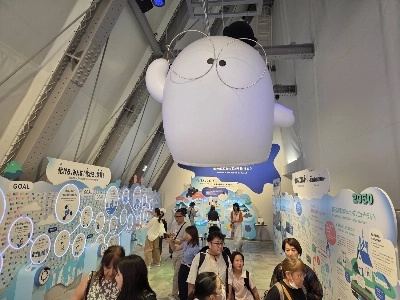“Jump in the sky.”
That’s the meaning of the kanji characters (空跳) that make up Sorato Shimizu’s given name, and you could say his parents were onto something.
Earlier this year, the 16-year-old sprinter ran 10 seconds flat in the 100 meters — which is often referred to as a sport of successive jumps — setting a new world record for athletes under 18.
Shimizu, a student at Seiryo High School in Ishikawa Prefecture, set the record at the national high school championship in July and ultimately secured a spot as one of the members of Japan’s 4x100-meter relay team for the World Athletics Championships in Tokyo.
The teenager hopes to become a trailblazer in an event dominated by North Americans and Europeans.
“I want to run at sub-10 next year when I’m 17 years old,” Shimizu told reporters last month, days after he set the record. “Looking ahead, I’m aiming to run at the Los Angeles Olympics (in 2028). But my goal is to run a sub-10 during high school, so that’s what I’m aiming for, for now.”
Shimizu has been like a superhero among teenage track and field athletes over the past few years.
In 2023, he won the 200 at the national junior high school championship. But he quickly rose to fame when he entered high school in 2024, running at 10.26 seconds in his first year, nearly half a second faster than his personal best of 10.75 seconds the year before. That run set a new national record for his age group, previously held by Abdul Hakim Sani Brown, the only Japanese athlete to ever qualify for a 100 final at the World Athletics Championships.
Shimizu found a new gear this year, winning gold in the 100 meters at the 2025 Asian U18 Athletics Championships in April before he ran 10 seconds flat in July. And now, he may be running in the relay at the World Athletics along with Sani Brown, Yoshihide Kiryu — the first Japanese to run a sub-10 — and Hiroki Yanagita, another rising sprinting star.
“He ran at 10.00 seconds even though he is a high schooler,” said Kazuhiko Yamazaki, chairman of high performance at the Japan Association of Athletics Federations (JAAF) during a news conference held on Sept. 2 to announce the members of the national team. “I have high expectations for him as a potential X-factor (for the relay team).”
The relay heats are scheduled for Saturday, with the finals taking place the following day.
So what makes Shimizu, who stands at just 164 centimeters tall, one of the fastest runners in Japan?
Miki Nishino, a track and field coach at Seiryo High School, said Shimizu employs two techniques that make him a great sprinter.
“What really stands out is how good he is at working the upper and lower body in sync, and how precise his ground contact is to capture the repellent force from the ground when he speeds up at the start,” Nishino said during a TV Kanazawa program in June. “He rarely misses his contact point. It’s amazing.”
The teenage sprinter has been training to increase his shoulder blade flexibility, which has allowed him to improve the coordination of his upper and lower body.
Athleticism also runs in the family.
Shimizu’s father was a high jumper in high school who came fourth in his age group at a national meet, while his mother competed in the 100-meter hurdles at the national level.
But from a technical point of view, the movement of his thighs is what makes him a great sprinter, said Shigemori Omori, a professor of sports science at Kanazawa Seiryo University in Ishikawa Prefecture.
“When you want to run fast, the swing speed of the thighs is going to be the key,” said the former athletics coach for Team Japan, who also competed in the 1984 Los Angeles Olympics in the 400-meter hurdles.
“And Shimizu’s swing speed of the thighs is probably the fastest among any Japanese,” he said.
One other point working in Shimizu’s favor is his peak speed. Sprinters usually speed up until around 60 meters — when they reach top speed — and then slightly slow down toward the end.
“Shimizu is the fastest at top speed compared with any other sprinter in Japan, or he may be in the top two alongside Yanagita,” Omori said.
But for him to run faster, reducing the time he is in contact with the ground in a stride — even by one hundredth of a second — will be crucial.
If he can slash his ground contact time from around 0.08 seconds to 0.07 seconds in the future, he could run somewhere between 9.6 and 9.8 seconds, said Omori. A sub-9.8 run would put him among the top three in 2025. Only Usain Bolt, Tyson Gay and Yohan Blake have ever run under 9.7.
Shimizu represents the next wave of sprinting hopefuls for Japan, which has traditionally excelled in marathons but has had little success on the track.
After disappointment in the 100 heats on Saturday, Team Japan is aiming for a medal in the 4x100 meter relay with arguably its fastest members ever. Sani Brown ran 9.96 seconds last summer while Kiryu ran 9.99 seconds last month, the first time in eight years that he has gone under 10.00. Yanagita, Shimizu and Yuhi Mori have all run 10 seconds flat this year.
“Getting a medal for the relay on the last day (of the World Athletics) is a must,” the JAAF’s Yamazaki said earlier this month. “We are putting in all our efforts to get a medal, and the 4x100 relay has that potential.”
For now, Shimizu is simply excited to be able to compete on the world stage.
“Since this will be the first step in my track and field career, I don’t want to focus solely on chasing victory,” he said during a news conference on Sept. 8. “More than anything, I want to gain real experience and carry it forward into the rest of my track and field journey.
“I want to contribute to Japan and inspire many moments of excitement.”

























With your current subscription plan you can comment on stories. However, before writing your first comment, please create a display name in the Profile section of your subscriber account page.